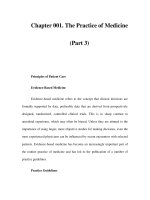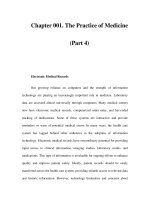Chapter 001. The Practice of Medicine (Part 4) pot
Bạn đang xem bản rút gọn của tài liệu. Xem và tải ngay bản đầy đủ của tài liệu tại đây (13.68 KB, 5 trang )
Chapter 001. The Practice of Medicine
(Part 4)
Electronic Medical Records
Our growing reliance on computers and the strength of information
technology are playing an increasingly important role in medicine. Laboratory
data are accessed almost universally through computers. Many medical centers
now have electronic medical records, computerized order entry, and bar-coded
tracking of medications. Some of these systems are interactive and provide
reminders or warn of potential medical errors. In many ways, the health care
system has lagged behind other industries in the adoption of information
technology. Electronic medical records have extraordinary potential for providing
rapid access to clinical information, imaging studies, laboratory results, and
medications. This type of information is invaluable for ongoing efforts to enhance
quality and improve patient safety. Ideally, patient records should be easily
transferred across the health care system, providing reliable access to relevant data
and historic information. However, technology limitations and concerns about
privacy and cost continue to limit a broad-based utilization of electronic health
records in most clinical settings. It should also be emphasized that information
technology is merely a tool and can never replace the clinical decisions that are
best made by the physician. In this regard, clinical knowledge and an
understanding of the patient's needs, supplemented by quantitative tools, still seem
to represent the best approach to decision-making in the practice of medicine.
Evaluation of Outcomes
Clinicians generally use objective and readily measurable parameters to
judge the outcome of a therapeutic intervention. For example, findings on physical
or laboratory examination—such as the blood pressure level, the patency of a
coronary artery on an angiogram, or the size of a mass on a radiologic
examination—can provide critically important information. However, patients
usually seek medical attention for subjective reasons; they wish to obtain relief
from pain, to preserve or regain function, and to enjoy life. The components of a
patient's health status or quality of life can include bodily comfort, capacity for
physical activity, personal and professional function, sexual function, cognitive
function, and overall perception of health. Each of these important areas can be
assessed by means of structured interviews or specially designed questionnaires.
Such assessments also provide useful parameters by which the physician can judge
the patient's subjective view of his or her disability and the response to treatment,
particularly in chronic illness. The practice of medicine requires consideration and
integration of both objective and subjective outcomes.
Women's Health and Disease
Although past epidemiologic studies and clinical trials have often focused
predominantly on men, more recent studies have included more women, and some,
like the Women's Health Initiative, have exclusively addressed women's health
issues. Significant gender differences exist in diseases that afflict both men and
women. Much is still to be learned in this arena, and ongoing studies should
enhance our understanding of the mechanisms of gender differences in the course
and outcome of certain diseases. For a more complete discussion of women's
health, see Chap. 6.
Care of the Elderly
The relative proportion of elderly individuals in the populations of
developed nations has been growing considerably over the past few decades and
will continue to grow. In this regard, the practice of medicine will continue to be
greatly influenced by the health care needs of this growing elderly population. The
physician must understand and appreciate the decline in physiologic reserve
associated with aging; the diminished responses of the elderly to vaccinations such
as those against influenza; the different responses of the elderly to common
diseases; and disorders that occur commonly with aging, such as depression,
dementia, frailty, urinary incontinence, and fractures. For a more complete
discussion of medical care for the elderly, see Chap. 9.
Errors in the Delivery of Health Care
A report from the Institute of Medicine called for an ambitious agenda to
reduce medical-error rates and improve patient safety by designing and
implementing fundamental changes in health care systems. Adverse drug reactions
occur in at least 5% of hospitalized patients, and the incidence increases with use
of a large number of drugs. No matter what the clinical situation, it is the
responsibility of the physician to use powerful therapeutic measures wisely, with
due regard for their beneficial action, potential dangers, and cost. It is also the
responsibility of hospitals and health care organizations to develop systems to
reduce risk and ensure patient safety. Medication errors can be reduced through
the use of ordering systems that eliminate misreading of handwriting.
Implementation of infection-control systems, enforcement of hand-washing
protocols, and careful oversight of antibiotic use can minimize complications of
nosocomial infections.









